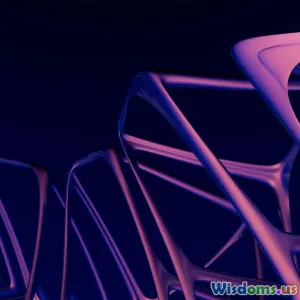
Do Jump Cuts Help or Hinder Narrative Flow
16 min read Explore the impact of jump cuts on narrative flow, analyzing benefits, drawbacks, and iconic examples to understand when this editing technique helps or hinders storytelling. (0 Reviews)
Do Jump Cuts Help or Hinder Narrative Flow?
Introduction: The Cut That Breaks The Rules
Film and video editing have always been alchemical processes—turning disconnected visuals into seamless stories that captivate viewers. But what happens when an editor intentionally breaks continuity, jarring the audience from one moment to the next using a technique known as the "jump cut"? Are they injecting much-needed energy into a scene, or breaking the delicate contract they've established with their audience?
In an era dominated by TikTok, YouTube, and even avant-garde cinema, jump cuts are everywhere. But does their growing prevalence mean they always contribute positively to the narrative flow? Or can they disrupt engagement, making stories feel incomplete or rushed?
This article dives into the craft behind jump cuts: their origins, varied uses, and the ongoing debate around their impact on narrative flow. Through real-world examples, critical insights, and practical tips, we demystify this divisive editing choice—and help you decide when (and how) to leverage its power.
What Are Jump Cuts? Understanding the Fundamentals
Defining the Jump Cut
A "jump cut" is an editing technique where two shots of the same subject, taken from slightly different angles or at slightly different times, are spliced together, creating an apparent 'jump' in the timeline. Unlike traditional editing, which aims for seamlessness via match cuts or fades, jump cuts lay bare the editorial hand—making the passage of time, or changes in pose and expression, feel sudden, even jarring.
Where Did Jump Cuts Come From?
Though editing as a language has been evolving for over a century, the jump cut traces its popularity to the innovations of French New Wave cinema in the 1950s and 1960s. Visionaries like Jean-Luc Godard used jump cuts to break cinematic conventions. In Breathless (1960), Godard's rapid-fire jumps across dialogue and movement weren't due to budget constraints—they were deliberate acts of rebellion against staid storytelling.
The Roots of a Trend
Jump cuts once symbolized the raw, the experimental, and the subversive. Today, they've become a visual hallmark in everything from vlogs to commercials—providing creative spark, humor, and pace. But has this overuse dulled their power?
How Jump Cuts Can Help Narrative Flow
Jump cuts are not just for rule-breakers or YouTube personalities. When used intentionally, they can serve valuable narrative purposes. Here’s how jump cuts might actually improve the storytelling experience.
1. Accelerating the Pace
One of the biggest assets of a jump cut is time compression. Rather than showing a character perform a mundane, multi-step task in real time, jump cuts can zap the audience ahead, keeping scenes brisk and engaging.
Example: A chef prepping a meal in a cooking montage might be shown dicing, mixing, seasoning—all in seconds, thanks to energetic jump cuts. Jamie Oliver’s popular kitchen series relies on these to tasty effect, making lengthy recipes appear simple and quick.
"Editing is the foundation of cinema as we know it. The jump cut just gives you a new set of tools to shape perception." —Walter Murch, acclaimed film editor
2. Evoking Humor and Surprise
Jump cuts, by their very abruptness, can introduce unexpected comedic beats. Think of YouTube stars cutting instantly between facial expressions or scenes to underline a punchline or reaction.
Example: Routine on vlogs like those of Casey Neistat often feature him in mid-explanation, only to comedically resume after an instant jump—giving the impression of ceaseless enthusiasm or unexpected interruptions.
3. Conveying a Character’s State of Mind
Jump cuts can represent psychological disarray, obsession, or stress. By fragmenting sequences, spiritual turmoil is made visual.
Example: In Darren Aronofsky’s Requiem for a Dream, rapid jump cuts show characters spiraling into addiction, underscoring their fractured reality and obsessive routines.
4. Breaking the Fourth Wall or Drawing Attention
Sometimes, breaking narrative seamlessness is the point. The audience, suddenly aware they are watching a constructed reality, can be compelled to question what they’re seeing.
Example: Jean-Luc Godard once declared, “A story should have a beginning, a middle, and an end, but not necessarily in that order.” In Breathless, jump cuts force viewers into a self-aware engagement with the film’s structure—an effect mimicked in Edgar Wright’s whip-fast editing in Scott Pilgrim vs. the World for comedic and meta-textual effect.
5. Establishing Energy and Modernity
Younger audiences, especially in internet-first productions, have come to expect rapid, punchy pacing. Jump cuts offer a visual shorthand for modernity and authentic immediacy.
Example: Fast-paced ad spots for tech products rely on punchy jump cuts to embody speed, innovation, and disruption. GoPro’s action camera ads thrive on these micro-narratives packed into seconds-long montages.
The Other Side: How Jump Cuts Can Harm Narrative Flow
Despite their advantages, jump cuts are not an editorial panacea. Used indiscriminately, they can alienate, confuse, or even exhaust audiences.
1. Breaking Immersion
One of narrative flow’s core functions is the suspension of disbelief. If jump cuts are too jarring or overexposed, audiences become hyper-aware of the edit, pulled out of the story.
Example: In otherwise immersive drama films, misplaced jump cuts can feel cheap or unprofessional. Beginners, seeking to emulate YouTube stars, sometimes sabotage the tone of their work—breaking emotional beats with unnecessary jumps.
2. Disrupting Emotional Continuity
Seamless cinematography and editing help audiences invest in characters' emotional arcs. Abrupt jumps can fracture these moments, particularly in drama or romance.
Example: A love confession, fragmented by abrupt editing, stops viewers from feeling the scene’s emotional rhythm. It’s one reason traditional Hollywood films use longer takes during emotionally charged sequences.
3. Confusing Viewers
If poorly executed, jump cuts can disorient viewers by skipping critical bits of information or spatial cues necessary to understand a scene’s geography or timeline.
Example: Low-budget YouTube skits sometimes cut so aggressively that continuity fades—glasses disappear, props change hands, or actors’ positions shift confusingly. This can break the narrative spell entirely.
4. Creating Unintentional Comedy or Parody
Unless the material calls for absurdity, inopportune jump cuts can falsely signal sarcasm, irreverence, or parody.
Example: A tense horror moment, inadvertently undercut by a sloppy jump, risks making audiences laugh instead of gasp. In serious genres, editing should bolster, not undercut, the intended mood.
Iconic Examples and Case Studies
French New Wave: Godard’s Breathless (1960)
Often considered the jump cut’s foundational text, Breathless used the technique to break pacing, suggest improvisation, and rebel against convention. Scenes of protagonist Michel driving through Paris, riddled with cuts mid-conversation, turn roadside chit-chat into electric engagement—or, for some, tiresome confusion. The effect divides critics and continues to spark analysis today.
“It was pure cinema—it was pure art, and it was exhilarating!” — Pauline Kael, legendary film critic, on Godard’s use of jump cuts
YouTube and Vlog Editing: The New Norm
Fast-growing digital creators innovate daily with jump cuts. PewDiePie, one of the world’s most influential YouTubers, uses rhythmic jump cuts to sustain viewer attention and amplify humor during long let’s-play sessions. His channel’s pacing would feel glacial with traditional editing.
Hollywood Homages and Modern Twists
Big-budget films also play with jump cuts for specific effect. In Snatch (2000), Guy Ritchie’s hyperactive sequences use tightly choreographed jump cuts to mirror character confusion and escalate tension, while Edgar Wright’s tightly synched comedic sequences relay frenetic experiences from protagonists’ perspectives.
The Psychology of Perception: Why and When Audiences Accept Jump Cuts
Viewer Expectation Shifts
Film theorist David Bordwell has remarked that visual grammar is always evolving. Today’s viewers, raised on rapid-fire media, are less likely to be bothered by jumps. Attention spans have shifted, making concise, high-impact editing almost mandatory online.
Gen Z and Millennials: Shorter, Sharper, Faster
Research by Microsoft (2015) suggests the modern average attention span is around 8 seconds, a finding hotly debated but echoed by trends in media consumption. For digital natives, protracted exposition is often a liability.
The Contextual Sweet Spot
But audiences are not one-size-fits-all. Mood, genre, and platform matter. What works on TikTok might fall flat in a cinematic release. The trick is reading the room: knowing when energy or efficiency trumps smoothness—and when it risks breaking the audience relationship.
Practical Guidelines: Making Jump Cuts Work For Your Story
For storytellers, deciding how—and when—to use jump cuts is as much about intent as execution. Here are actionable strategies for effective use:
1. Use Jump Cuts With Purpose
Reserve jump cuts for moments when you need to:
- Accelerate time without losing narrative cohesion
- Inject energy or comedy
- Reveal a character’s state of mind or psychological fragmentation
- Play with audience expectations
Pro Tip: Plan your shots knowing you’ll be jump cutting—positions, actions, and expressions should read clearly and consistently across cuts to avoid confusion.
2. Balance With Seamless Editing
Mix jump cuts with more traditional edits—match cuts, cross-dissolves, and L-cuts—to give viewers a visual breather and smooth out harsh transitions. This interplay establishes rhythm, letting abruptness serve rather than sabotage the story.
3. Mind the Genre
Comedy, action, and vlogs are natural homes for jump cuts. Dramas or experimental work can use them to profound effect, but overuse in slow-burning or romantic scenes risks shattering emotional continuity.
4. Retain Critical Information
Never cut away from essential plot or spatial cues. Viewers must be able to track story arcs, character positions, and key details, or risk disengagement.
5. Test Audience Reaction
Screen your edits (or rough cuts) for others—especially outside your own demographic. What’s punchy and clear to you may leave other viewers puzzled or stressed.
Industry Insights: Editor Quotes and Academic Studies
Top editors balance artistic intent with audience engagement. Consider these insights:
- "Every cut you make is a lie. The trick is to lie so the audience chooses to believe you." — Alice Winocour, film editor
A 2017 academic survey in Psychology of Aesthetics, Creativity, and the Arts found that moderate, purposeful use of jump cuts enhanced perceived dynamism in short films—but overuse correlated with reduced emotional connection, especially for viewers over 40.
Digital analyst Nick Robalik points to jump cuts as “the punctuation in the sentence of a video. Used sparingly, they add rhythm and highlight. Used too often, they turn the story into staccato noise.”
Future Trends: Where Are Jump Cuts Heading?
With short-form platforms growing—TikTok, Shorts, Instagram Reels—the jump cut’s star only rises. AI-assisted editing tools now offer automatic jump cuts to highlight action, excise silence, and keep runtime tight for waning attention spans.
But narrative sophistication remains a premium commodity. As Netflix and prestige filmmakers push for ever-smoother storytelling, the jump cut increasingly becomes a stylistic signifier rather than a universal standard. It represents choice, not necessity.
Conclusion: Cutting to the Heart of the Narrative
So, do jump cuts help or hinder narrative flow? The answer is as nuanced as storytelling itself.
Used thoughtfully, jump cuts can enliven narratives, elegantly compress time, convey psychological states, and connect with modern viewers' expectations—especially online. They’re powerful tools for establishing pace, humor, verve, and even artistic meta-commentary.
Yet, overuse or thoughtless application risks alienating audiences, breaking emotional continuity, or muddling clarity. Like any cinematic device, their impact depends not on the tool, but the hands wielding it.
The next time you find yourself on the editing timeline, ask not just how much to cut—but also why. Use jump cuts to command your audience’s attention, not just their compliance. In today’s multimedia landscape, the jump cut is less a blunt instrument and more a brush stroke—capable of painting narratives with vivid immediacy, if you know where (and when) to make it.
Actionable Takeaway: Analyze your story goals and target audience before defaulting to jump cuts. Use them consciously, not compulsively—and let narrative intent drive your editing, not just trends.
Rate the Post
User Reviews
Popular Posts















